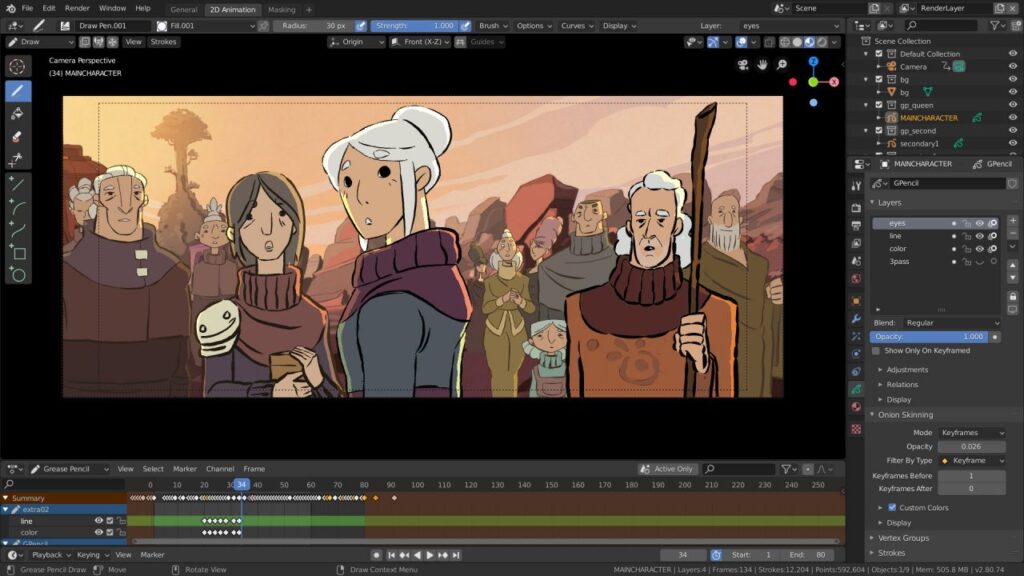What is Blender?
Blender is a free, open source 3D computer graphics software toolset used for modeling, animation, simulation, rendering, compositing, and motion tracking. Initially released in 1995 by creator Ton Roosendaal, Blender has grown to become a popular choice for 3D projects across diverse industries from film visual effects to video games to architecture.
Key capabilities include 3D modeling, texturing, lighting, animation, physics simulation, video editing and compositing. Blender offers a python API for customization and has an expansive plugin ecosystem. A major advantage of Blender is its price – completely free and open source even for commercial use. While not as beginner-friendly as some 3D software, Blender is highly capable once learned and has an avid community supporting its development.
The Blender Foundation spearheads improving Blender with public releases every few months. With its comprehensive toolset and accessible pricing, Blender has become an appealing option for everyone from indie creators to large studios needing high-end 3D tools on a budget.

Technical Characteristics
- Sculpting – High quality brush-based sculpting tools for detailed organic models.
- UV unwrapping – Tools to seamlessly map textures onto 3D models.
- Texturing – Procedural and manual texture painting. Node-based materials system.
- Shading – Real-time PBR renderer with various shader nodes. Ray tracing support.
- Animation – Keyframe and curve-based animation tools with IK, baking, and constraints.

Features
Advantages
- Full-featured toolset – Provides a very extensive and cohesive set of modeling, animation, and rendering tools.
- Popular format support – Can import/export common formats like FBX, OBJ, glTF, USD, DAE, Alembric.
- Active development – Large development community constantly adding new features and improvements.
- Customizable – Highly customizable via Python scripting and an expansive add-on ecosystem.
Disadvantages
- Video editing limitations – Blender’s video editing tools are not as advanced as specialized software like Premiere Pro or Final Cut Pro. The workflow may not be ideal for extensive video projects.
- Game engine not on par – Blender Game Engine is not as robust or well-supported as standalone game engines like Unity or Unreal for complex games.
- Less extensive library – Blender lacks the huge library of pre-made assets, models, materials, plugins etc. that some commercial software have. Users need to create more content from scratch.

What’s new
- Blender 3.0 (2021) – OptiX viewport denoising, new asset manager,Geometry nodes, improved sculpting tools, better UV editing workflows.
- Blender 2.90 (2020) – Interactive sculpting brush, scatter add-on for distributing objects, convergence tools for retopology, de-interlace option.
- Blender 2.83 (2020)- Improved viewport performance, new real-time rendered EEVEE, better mesh editing tools, new file browser.

System Requirements
- Operating System: Windows 7 or higher, macOS 10.12 or higher, Linux.
- Processor: A mid-range Intel or AMD processor with 4 cores like Intel i5 or AMD Ryzen 5. More cores are better for complex 3D work.
- RAM: Minimum 8GB, but 16GB or higher is recommended. Insufficient RAM can cause crashes with large scenes.
- Graphics Card: A dedicated NVIDIA or AMD GPU with at least 2GB video memory. CUDA enabled NVIDIA cards work best for Cycles rendering.

How to download Blender
- First
Click on the “Download” button at the bottom of this page to download the latest stable release of Blender.
- Second
Once the download is complete, unzip the folder and install Blender by running the installer executable file on Windows or pkg file on macOS. On Linux, extract the tar.xz archive and run the Blender executable to launch.
Activation keys
- 9S7J7-85DQP-KC6AA
- 7M39F-9H83P-DEOR6
- M757S-5E384-E446J
- SRQ46-8ID36-8JN8Q
- K53T6-F3JJ6-2727D

Alternatives progams for 3d modeling
- Autodesk 3ds Max – Popular commercial software for 3D modeling and rendering for games and design visualization.
- Cinema 4D – Used extensively for motion graphics and visualization. Easier to use with great workflow.
- Modo – Advanced polygon and subdivision surface modeling tools combined with rendering and sculpting.
- ZBrush – Specialized digital sculpting program for highly detailed organic models and textures.

FAQ
A: Blender with activation code allows you to create 3D models, animations, motion graphics, interactive 3D applications, video editing projects, games and more. It has tools for the entire computer graphics pipeline.
A: Yes, Blender has powerful sculpting capabilities through tools like Dyntopo, Multi-resolution Modifier and the Texture Displacement modifier. The fast Grbrush engine allows you to sculpt high resolution detailed organic models.
A: Yes, Blender projects can be used for any purpose including commercially because Blender is licensed under GPL which allows free use, modification and distribution without any restrictions. Moreover, the duplicate and invert functions allow for quick replication and alteration of objects or movements. The graph editor provides precise control over keyframes, while the armature modifier enables the creation and manipulation of skeletal structures.
Conclusion
Blender is a versatile program that offers a wide range of tools and features for artists and designers. It allows users to create and manipulate 3D models using a variety of techniques and functions. The latest version, which is available on blender.org, includes enhancements such as improved performance and stability. The program has a user-friendly interface, making it easy to navigate and work with different elements.

Users can utilize the vertex and stroke tools to create intricate details and fine-tune their models. The grease pencil feature allows for sketching and annotations directly onto the 3D viewport. Additionally, the program supports exporting options for various file formats, enabling seamless integration with other software. The NLA (Non-Linear Animation) editor provides a convenient way to organize and control complex animations.
Blender also offers 2D drawing capabilities and sculpt mode for more intricate detailing. Anisotropic line art modifier and CPU rendering capabilities further enhance the program’s flexibility and performance. Blender is a powerful and comprehensive tool for artists and designers looking to create high-quality 3D models and animations.
